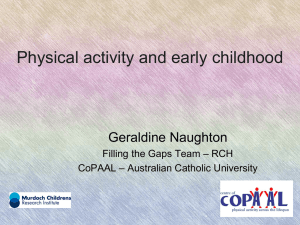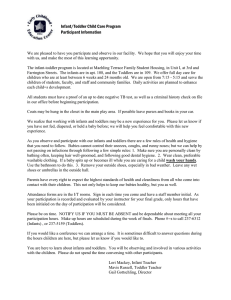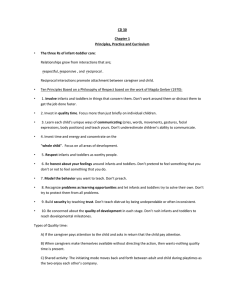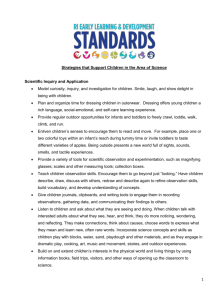National Physical Activity Recommendations for Children 0
advertisement
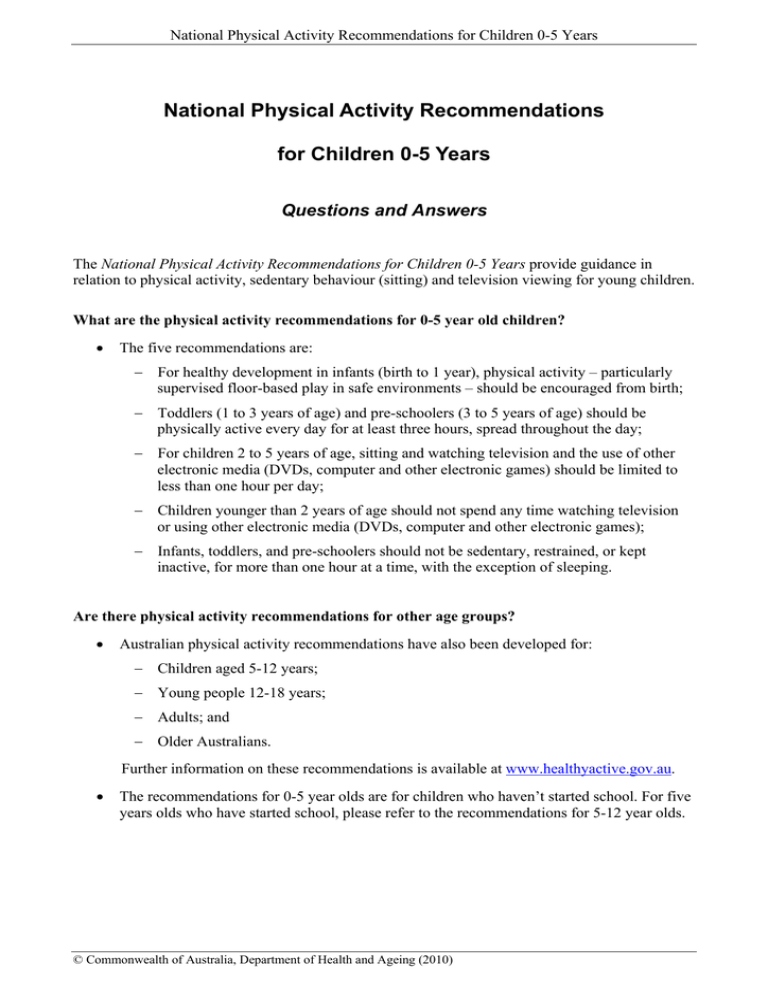
National Physical Activity Recommendations for Children 0-5 Years National Physical Activity Recommendations for Children 0-5 Years Questions and Answers The National Physical Activity Recommendations for Children 0-5 Years provide guidance in relation to physical activity, sedentary behaviour (sitting) and television viewing for young children. What are the physical activity recommendations for 0-5 year old children? • The five recommendations are: − For healthy development in infants (birth to 1 year), physical activity – particularly supervised floor-based play in safe environments – should be encouraged from birth; − Toddlers (1 to 3 years of age) and pre-schoolers (3 to 5 years of age) should be physically active every day for at least three hours, spread throughout the day; − For children 2 to 5 years of age, sitting and watching television and the use of other electronic media (DVDs, computer and other electronic games) should be limited to less than one hour per day; − Children younger than 2 years of age should not spend any time watching television or using other electronic media (DVDs, computer and other electronic games); − Infants, toddlers, and pre-schoolers should not be sedentary, restrained, or kept inactive, for more than one hour at a time, with the exception of sleeping. Are there physical activity recommendations for other age groups? • Australian physical activity recommendations have also been developed for: − Children aged 5-12 years; − Young people 12-18 years; − Adults; and − Older Australians. Further information on these recommendations is available at www.healthyactive.gov.au. • The recommendations for 0-5 year olds are for children who haven’t started school. For five years olds who have started school, please refer to the recommendations for 5-12 year olds. © Commonwealth of Australia, Department of Health and Ageing (2010) National Physical Activity Recommendations for Children 0-5 Years What is physical activity for young children? • Physical activity for young children primarily occurs through unstructured, active play. It also includes walking to places and more structured activities such as water familiarisation, dance and gymnastics programs. • Physical activity for Infants (first 12 months of life): − Activity or movement in the first 6 months of life includes reaching for and grasping objects; turning the head toward stimuli; and movement of the arms and legs whilst lying on the stomach (‘tummy-time’). − The second six months of life is characterised by learning basic movement skills such as crawling, pulling up to a standing position, creeping whilst using an object for support, and finally walking. • Physical activity for Toddlers (1 – 3 years of age): − Physical activity for toddlers is characterised by active play and learning locomotor skills including running, jumping, hopping, galloping and skipping. − Activity may also include stability skills, including balancing and climbing. Toddlers also experiment with object control skills such as kicking, catching, throwing, striking, and rolling. − Structured activities such as water familiarisation, dance and gymnastics based programs may also provide valuable opportunities for toddlers to be active. • Physical activity for Pre-schoolers (3 – 5 years of age): − Further development of locomotor, stability and object-control skills occurs during this period. It is important to provide pre-schoolers with opportunities to practice these skills, and to give feedback and encouragement. Why should young children be encouraged to be physically active? • Being physically active can help young children to achieve and maintain a healthy weight. It can also help children to develop strong bones and muscles, as well as movement patterns and motor skills. • Physical activity can also provide opportunities for young children to interact with others, make friends and develop social skills. • Encouraging kids to be active when they are young can establish a pattern that could stay with them throughout their life. What about physical activity for young children with a disability? • All children should be encouraged to be active whatever their level of ability. • Advice should be sought from health care providers to identify the types and amounts of physical activity that are appropriate for young children with a disability. © Commonwealth of Australia, Department of Health and Ageing (2010) National Physical Activity Recommendations for Children 0-5 Years How can parents and carers encourage children to be more physically active? • Parents and carers can encourage their child to be active by interacting with them in a gentle, physically active way as often as possible. As important role models, the involvement of parents and carers can help foster the child’s involvement in, and enjoyment of, physical activity and play. • It is important to allow children the freedom to create, imagine and direct their own play, and to undertake activities that encourage independence and appropriate risk taking (e.g. walking along a low wall), while maintaining a safe and supervised environment. • Being active with children can also benefit parents and carers own health and may assist them to meet the National Physical Activity Guidelines for Adults. • To further promote physical activity, parents and carers should consider child-care providers who promote physical activity and have adequate space and equipment. Does the recommended 3 hrs of physical activity for 1-5 year olds need to be of a particular intensity? • No. The recommended 3 hrs of physical activity per day can include light intensity activity such as standing up, moving around and playing as well as more vigorous activity such as energetic play. • Typical physical activity patterns of young children are characterised by short intense bursts of activity broken up by periods of rest or low intensity activity. The recommended 3 hours should be accumulated throughout the day, rather than all at once. • Rather than intensity, it is the amount and the nature of the physical activity that is important. Physical activity for young children should be fun; encourage exploration and guided-discovery; and be focused on active play. Light Activity includes a wide range of activities like standing up and moving around, walking at a slow pace and less energetic play. Moderate Activity is similar in intensity to a brisk walk, and could include a whole range of activities like playing at the park, any sort of active play or riding a bike. Vigorous Activity will make kids “huff and puff” and includes running, jumping, skipping and may include more organised activities like dance and gymnastics programs. Any sort of active play will usually includes bursts of vigorous activity. © Commonwealth of Australia, Department of Health and Ageing (2010) National Physical Activity Recommendations for Children 0-5 Years Why does the recommended amount of physical activity per day drop from 3 hours for 1 - 5 year olds, to 60 minutes per day for 5 – 12 year olds? • The 3 hours of physical activity recommended for 1-5 year old children includes light intensity activity, through to moderate-to-vigorous intensity physical activity. The 60 minute recommendation for older children only includes moderate-to-vigorous intensity physical activity. • In addition, it is generally recognised that physical activity levels are likely to decline when children start school. For this reason it is important that young children are participating in substantially more than the recommended 60-minutes of moderate-to-vigorous activity for school-age children when they start school. Where can children be physically active? • Children can be encouraged to explore and play in both indoor and outdoor environments with access to space and equipment that is suitable and safe. • Outdoor settings provide lots of opportunities for physical activity. However, many activities, such as moving to music, dress-ups, playing with balloons, games like hide-andseek and obstacle courses can also be undertaken in restricted outdoor environments (eg. verandas and yards) and indoors. Why is it recommended that children under 2 years should not watch any TV (i.e. no screentime for under 2 year olds)? • A variety of TV programs have been created for children under 2 years, however it is questionable whether TV enhances development in the first two years of life. • There is some evidence indicating that TV watched in the first 2 years of life may be associated with delays in language development. A study conducted with children aged 1548 months found that children who started watching TV under the age of 1 year, for more than 2 hours per day, were approximately six times more likely to develop language delays 1 . • Research has also found that the distraction of background television can interfere with children playing and interacting with family members and others, which are important for language development1, 2. • In addition, research has found that each hour of daily TV watched by children under the age of 3 years is associated with poorer reading and intelligence 2 , and that greater amounts of TV viewing as an infant is related to a increased likelihood of attention problems at age seven. • Perhaps the most important factor for parents and carers to consider is the undeniable benefits associated with children participating in active play and interacting with others. Through play and interaction young children learn valuable movement and communication skills. © Commonwealth of Australia, Department of Health and Ageing (2010) National Physical Activity Recommendations for Children 0-5 Years What are some alternatives to TV when children need some “down-time”? • It is recognised that there are times when children need to play quietly and have some “down-time”, particularly before bed or when they are unwell. • Some “down-time” activities that can encourage interaction and assist in the development of fine motor skills are: − reading or looking at books; − drawing or colouring in; − building with blocks or lego; − playing with playdough or clay; and − doing a jigsaw puzzle. Why are baby walkers and jumpers not recommended for young children? • Baby walkers can be dangerous as they allow infants to move more quickly around the house and reach hazards such as stairs, fireplaces or dangerous objects before a parent/carer realises. There is also a risk of injury due to falls 3 . • Rather than helping infants learn to walk, baby walkers and jumpers tend to reduce the time that infants spend on the floor which is an important step toward independent walking. Floor time allows infants to roll, crawl and creep, and eventually progress to pulling themselves into a sitting and then standing position. These are all important pre-walking skills that infants need to be encouraged to develop3. What is meant by the term “sedentary”? • The National Physical Activity Recommendations for Children 0-5 Years state that “Infants, toddlers and pre-schoolers should not be sedentary, restrained, or kept inactive, for more than one hour at a time, with the exception of sleeping”. • “Sedentary behaviour” refers to time spent being physically inactive, and includes time spent sitting watching TV; or when sitting (restrained) in a car seat, stroller, high-chair, baby walker or jumper, or even in a bike seat. • As children tend to be naturally active, it is best to limit activities that require children to sit for long periods and take active breaks regularly. Why is competitive sport not recommended for 0-5 year olds? • The official, rule based environment of competitive sport is not considered suitable for young children 4 . Instead, the emphasis for this age group needs to be on enjoyment, play and opportunities to learn basic movement skills like walking, jumping, running, throwing, catching and kicking in a non-competitive environment. • The skills that young children develop through active play form the basic building blocks for more specific skill development that may be used in sporting activities in the future. • Interactive play also assists in the development of important social skills and a positive attitude and enjoyment of physical activity. © Commonwealth of Australia, Department of Health and Ageing (2010) National Physical Activity Recommendations for Children 0-5 Years References 1 Chonchaiya W, Pruksananonda C. Television viewing associates with delayed language development. Acta Paediatricia 2008; 97:977-982. 2 Christakis DA. The effects of media usage: what do we know and what should we learn? Acta Paediatrica 2009; 98:816. 3 Australian Physiotherapy Association (2007): Baby walkers [Available at http://www.physiotherapy.asn.au/images/Document_Library/Position_Statements/baby%20walkers.pdf Accessed 22 July2010]. 4 Côté J. Junior Sport Framework Briefing Paper - Opportunities and Pathways for Beginners to Elite to Ensure Optimum and Lifelong Involvement in Sport, Australian Sports Commission, December 2006. © Commonwealth of Australia, Department of Health and Ageing (2010)

